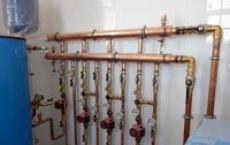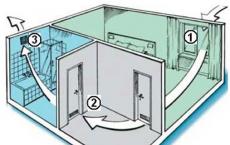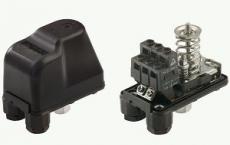Purge the heating of an apartment building. Flushing the heating system of a residential house is an effective technique.
Surely, each of you at least once in my life came across a very unpleasant situation, when in the midst of the heating season the batteries suddenly began to heat up the house badly. Moreover, as consumers note, along with the low heat dissipation of radiators, the amount of consumed resources remained at the same level.
Experts explain this phenomenon by the fact that the highway sometimes clogs. And this, in turn, leads to a reduction in the useful volume of the pipeline and, as a consequence, to a decrease in the heat transfer of heating appliances. Therefore it is important to know how to flush the heating system in a private house, so that if not to freeze, but absolutely sure to keep warm.
Where in the radiators dirt
As a rule, water is used as a coolant. The most common water, which is taken from both a centralized pipeline, and from a well or a nearby pond. In the first case, various chemical substances are added to the coolant, in most cases, which are subsequently deposited on the walls of the heat main in the form of scale. In the second, it is somewhat more complicated. Well, if at the entrance to the boiler you have a good filter station, which cleans water from the well (pond) from sand, silt and other fine particles. However, not everyone has a thermal unit equipped with a similar plan, as a result of which the mud remains on the walls, layered, resulting in narrowing the aisles.

It is for this reason that cleaning heating system in a private house is an extremely important and necessary procedure, without which, alas, heating will not be so effective and economical.
The formation of scale on the inner wall of the thermal circuit, the thickness of which varies from 0.8 cm and higher, leads to a decrease in the efficiency of the functioning of the unit by 35%. Time spent cleaning the heating system will reduce the heat loss of such a plan.
Moreover, the presence of foreign bodies in the heating main reduces the operational life of the entire heating block. And this, in turn, leads to additional costs for the purchase of a new boiler, as well as for the re-equipment of the heating system as a whole. Therefore, it is worthwhile to prioritize.
And although the rate of pollution does not directly depend on the material from which the radiators are made, do not discount the corrosion process.
How to determine the presence of scale
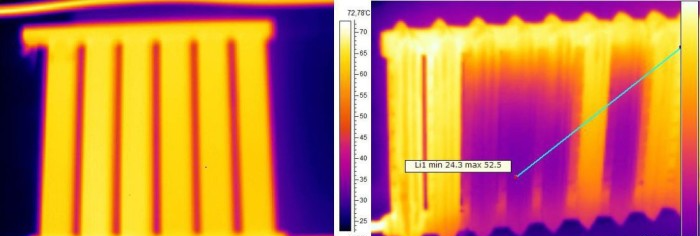
The thermal imager data - on the right figure the battery is 40% contaminated
Of course, it is extremely difficult to determine the need for washing the heating system in terms of external characteristics. But at the same time, find out if the heat in the heat pipe is easy enough. Thus, the main indicators of mud formation on the internal surfaces of heating appliances and the hot water supplying them to pipes, as well as the need for performing such a procedure as washing the heating systems, are:
- reduction in the rate of heating of heat exchangers;
- the functioning of the heating boiler is accompanied by extraneous sounds that have not previously been observed;
- partially cold battery - in the upper part it is cold, and at the bottom - hot or vice versa;
- the radiator is completely cold, whereas the supply pipe to it is warm;
- increase in the consumption of consumed fuel resources for warming up to the necessary temperature regime in the room.
In addition, often in the heat circuit a raid is formed a few days after it was connected to another heating device. This is due to the fact that the new elements should, so to speak, "get used to" the work of the entire assembly. Moreover, they are treated with special substances that prevent the formation of corrosion. And when they pass through them heated to a certain level of water, these paint components are washed off and gradually turn into plaque, coming into contact with other substances.
How to cope with the problem
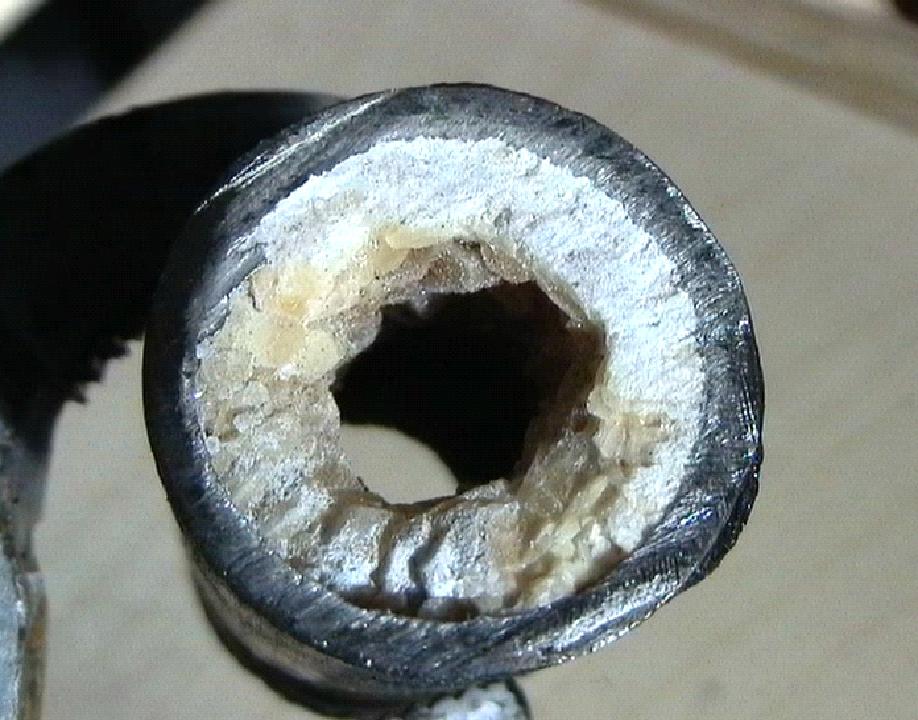
Thanks to modern technologies, there are mechanical and chemical ways of washing the heating system.
Mechanical
The old kind old-fashioned method, in which pipes are dismantled and manually by means of hard brushes, wires and spokes clean all surfaces from scale. Before proceeding, a thinning chemical (Mole, etc.) is poured into the pipes, which softens the layers and makes it possible to scrape them off quickly. The drawback of the method lies in the length, complexity and understanding of how the system works, how to disassemble it, but most importantly - how to assemble it after cleaning.
Chemical
A modern way that allows you to get rid of scale and limestone deposits almost at the height of the heating season. For washing, a pump is connected to the system to distill water with a certain chemical composition, depending on the method, acidic or alkaline.
Now for more details about the most effective methods. Through which you can clean the heating system with your own hands.
Pulsational-aqueous composition
This variant of cleaning the heating of a residential house is carried out by means of special equipment. With the help of such units, the thermal circuit is filled with a mixture of compressed air masses and water. On the final account, cleaning of the inner walls of the pipeline and heat exchangers is achieved through active wave ripple.

This way of washing the heating system in a private house is good because it allows literally 15 minutes to get rid of the accumulated pollution in the main and radiators. And this, in turn, significantly extends the operational life of both the heating element and the entire heat circuit as a whole.
Timely cleaning allows reducing fuel consumption. Therefore, do not neglect such a procedure as flushing the heating system.
Biopreparations
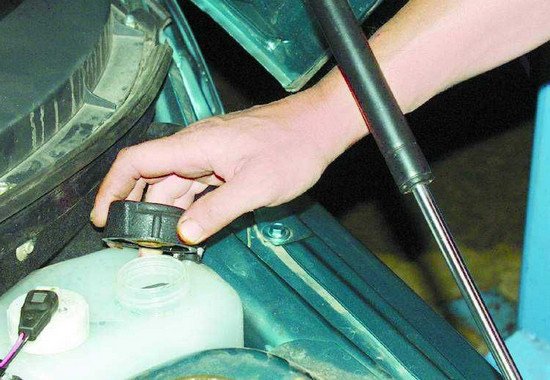
The advantages of this cleaning option is that there is no need to disconnect the heating system. So, biologically active preparations are added to the water, which in a literal sense dissolve any kind of pollution, whether it is rust, or scum. And besides, there is no need to call specialized employees, as in the previous method of cleaning. In addition, biopreparations belong to the group of ecologically safe compounds, both for human health and for the environment.
The technique of "Pneumohydewar"

In this case, special equipment is also used, by means of which short-wave high-frequency pneumohydrotools are created. Despite the testimonies of some people who say that such measures can harm the heating block, do not be afraid that as a result of this treatment option the heat circuit itself will be damaged. And all because the lion's share of the impact force (and this is more than 90%) falls on the flow of the coolant. This method of cleaning is used, in most cases, in enterprises where the risk of plaque and rust is very high, as is the length of the entire heating pipeline.
VIDEO: Cleaning with a Typhoon pneumatic gun
Use of chemicals
This method, most often, is used for cleaning a contour of a complex configuration. And if the heat circuit in your house has many turns and drops, then this option will best help get rid of rust, scale and deposits accumulated in the pipeline and batteries.
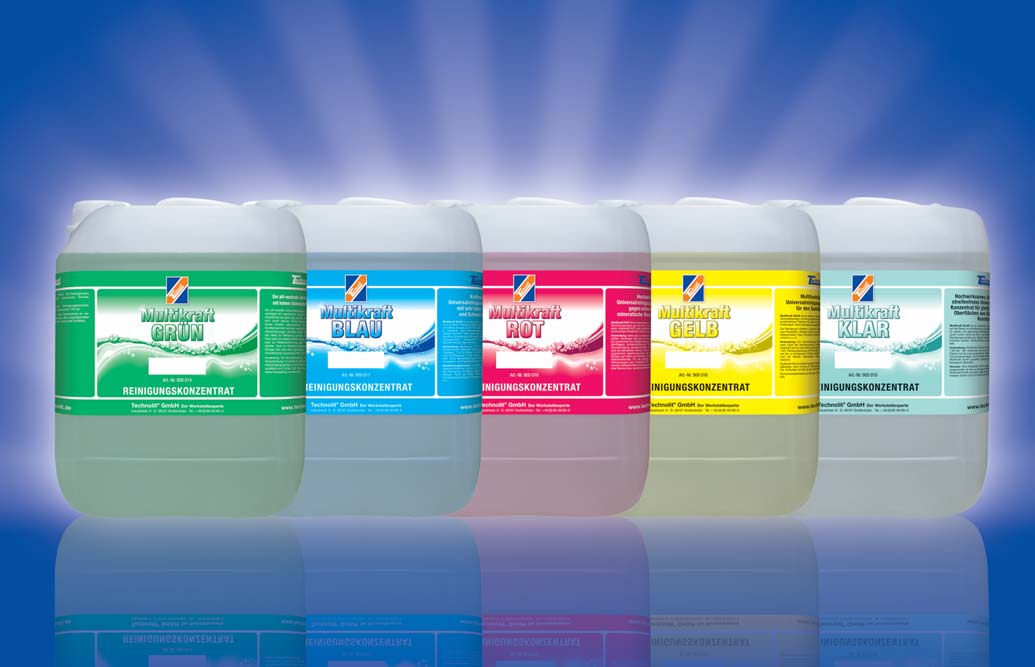
The flushing liquid in this case consists of two or three kinds of acids that are capable of literally clearing the pipeline in 15-25 minutes from contamination, while increasing the useful volume of the pipeline and heat exchangers.
Using chemical substances for cleaning, it is necessary to be extremely cautious. As this can lead to burns. It is best to use protective equipment in the form of glasses, gloves and masks.
In addition, this method of cleaning can remove several millimeters of the main material from which the pipeline and radiators are made. And this, in turn, can lead to leaks. Therefore, before using chemicals, determine the wear level of all components of the unit. And if the walls of the main or heat exchangers are already worn out, it is better to give preference to another option.
Use of one of the above cleaning methods depends on the condition of the main and heat exchangers, as well as on the level of their contamination. And if you correctly carry out the procedure for cleaning the heating unit, it will serve you for a long time, providing comfortable temperature conditions for living.
VIDEO: Flushing the heating system
Maintenance of heating systems in apartment buildings carried out management company. Residents of the private sector have to independently monitor and prevent activities that ensure the functioning of the equipment. Timely repairs, cleaning, modernization will save money on heating the home, and extend the life of the boiler and other devices.
One of important milestones preparatory work To a new heating season is the flushing of the heating system. This is a kind of cleaning of the pipes of the circuit and heating devices from contamination resulting from corrosion of the metal surface and scale.
Signs of contamination of heating pipes
There are prerequisites that signal the need to perform washing:
• uneven heating of radiators;
• Decrease in room temperature with stable operation of the boiler;
• slow heating of the circuit;
• Different temperature of the pipeline and batteries;
• frequent appearance of fistulas in tubes or ruptures.
If one or more of the following factors are detected, it is recommended to clean the system.
Causes of contamination of heating pipes
The primary problem of the formation of pollution in pipes is rust. Metal under long-term exposure to damp media is corroded. Over time, along the pipeline along with the coolant, fragments of rust begin to circulate, gradually accumulating in the circuit. Sor is deposited in the bends and corners of the contour, which provokes the appearance of fistulas and ruptures. In addition, the flow capacity of the coolant is lost, therefore, different temperature conditions are observed at certain sections of the pipeline.
Read also: How to choose the right bathroom sink? Types of shells in shape, appearance and functionality, according to the material of manufacture
Another not less dangerous cause is scum. It even covers plastic pipes, clogging the system with small fragments. The quality of the water used, which fills the circuit, also leaves much to be desired. Therefore, the formation of siltation and other debris no longer surprises anyone.
For the sake of justice, it should be noted that both metal structures and plastic are susceptible to contamination. PVC pipes except that they are not covered by corrosion. From this it follows that any heating systems need to be serviced.
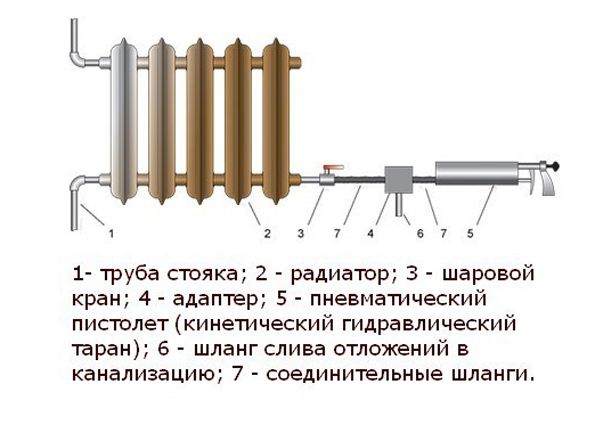
The frequency of flushing the heating system in a private house
Doing cleaning work fanatically is not worth it. In any case, it is problematic to remove all garbage from the circuit, especially in systems that have been operating for more than a decade. However, it must be remembered that at the beginning of each heating season, the pipes should be flushed. After the system is disconnected, constructions made of metal need to be cleaned. Plastic products are sufficient for maintenance once a year.
The cleaning process itself is quite simple, every owner can handle it. Before carrying out preventive measures, you should familiarize yourself with the rules of their conduct.
Read also: Warm floor: premises under the warm floor, methods of installation of cable constructions, types of warm floors, selection criteria

Washing the heating system in the house with your own hands
Cleaning the heating system is carried out in several ways.
1. Chemical flushing provides for the use of a special solution (alkali, mineral and organic acids, solvents) and simple devices: pump, hose, drainage tank.
Stages of work:
• completely drain the water from the system;
• pour a special solution;
• Connect a pump to the pipeline to pump the solvent for several hours;
• drain the liquid with reagent;
• Rinse the pipes with clean water.
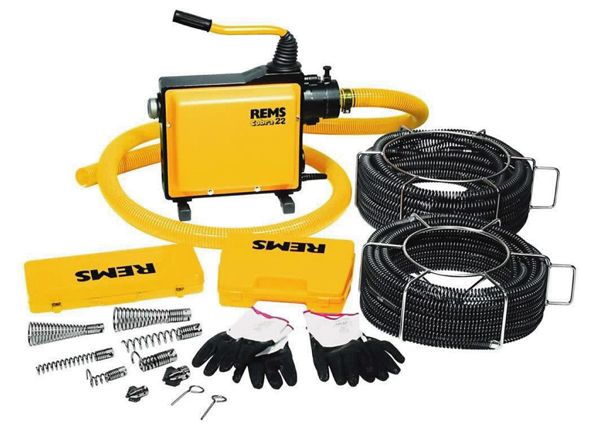 This method has a high cleaning rate (up to 100%), but it is only allowed to use it in metal structures. If the circuit of the circuit is equipped with aluminum radiators, the chemical solution can significantly damage them. Therefore, before using reagents it is worth consulting with a specialist or carefully studying the contraindications to the use of the solvent.
This method has a high cleaning rate (up to 100%), but it is only allowed to use it in metal structures. If the circuit of the circuit is equipped with aluminum radiators, the chemical solution can significantly damage them. Therefore, before using reagents it is worth consulting with a specialist or carefully studying the contraindications to the use of the solvent.
Precautionary measures:
• When working with a chemical solution, rubber gloves should be worn;
For the heating system to remain effective and efficient for the longest time, it must be periodically washed. This simple measure in its carrying out allows to eliminate scum and various garbage from the system elements.
According to the rules, the washing of the heating system should be done by specially trained people. But if you want, you can do it yourself. Study the guide and proceed.
Have you noticed that one of your friends or neighbors has a much warmer battery than your home? There may be several reasons for this, but the most common is the presence of clogging in the heating mains. It is to eliminate such troubles and prevent their further appearance and flushing is performed.
The efficiency of heating is reduced due to two main factors, namely:
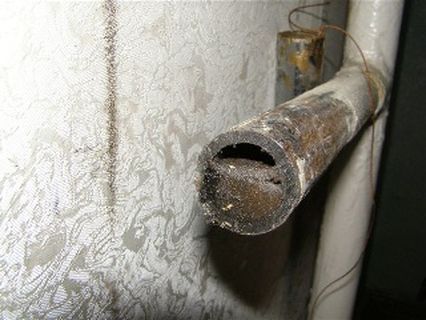
To the greatest extent silting are susceptible to cast-iron batteries, as well as radiators with a large number of sections. The dependence is simple: the more sections and the more bulky, the slower the coolant moves through the system and the higher the probability of silting.
Instructions for flushing the heating system
There are 2 main methods of washing the heating system, namely:
- with the use of special hydropneumatic equipment;
- using chemical reagents.
Hydropneumatic washing
Hydropneumatic flushing of heating systems - instruction
This method is actively used by domestic ZhEKs and is quite effective. You just need to do everything in accordance with the technology.
The principle is extremely simple: first the water is discharged from the system, then it is fed back. A special pneumatic pump is used to "adjust" the water flow. As a result, under the influence of a rather powerful head, scaling of the scale and other deposits occurs, and when draining the water, they are removed from the system.
To perform this procedure on your own, you will need a pneumatic pump that can pump more than 6 kg / cm 2.
The sequence of actions is as follows.
First step. We close the gate valve "return".
The second step. We connect the pneumatic pump to the valve installed after the valve.
The third step. We drop the "return".
The fourth step. We give the pneumatic pump to apply pressure above 6 kg / cm 2, and then open the valve to which it is connected.
Fifth step. Alternately overlap all the risers. We do this so that at a time no more than 10 risers are blocked. Compliance with this rule will make the washing procedure as efficient as possible.
The sixth step. We translate the system to a drop in the opposite direction. For this we do the following:
- close the reset and close the valve connected to the pump, and turn off the device;
- close the open latch, and then open the similar on the "return";
- reset the heating system. To do this, we connect the pneumatic pump to the valve in the reverse direction, then open the valve and turn on the pump. The fluid will move in a different direction.
Determine the required duration of washing can be "by sight". A clean, clear liquid started to come out of the system? You can finish! Return the valves and valves to their original position and turn off the pump.
To collect dirty water, prepare a suitable container. If you want, you can connect the hose to the battery and ensure that the dirty coolant is diverted to the sewerage system.
Chemical washing
The use of this method can only be resorted to in two cases, namely:
- if necessary, clean the heating system with natural circulation, built using steel pipes. The use of chemical reagents is advisable in situations where, for any reason, there is no desire to wash the entire system. Most often, blockages are deposited in heat exchangers. The system can be silenced on the entire perimeter. In the second case, there will not be a special kind of chemical washing;
- if necessary, restore the old heating system. Over the decades of operation, the pipes can become clogged and overgrown so that the capacity of the pneumatic pump will not be sufficient for effective cleaning. It is possible, of course, to take a more powerful pump, but no one will guarantee that the pipes will not burst under such pressure.
Important! If the pipes are very old, with traces of corrosion and deformation damages, there can be no positive result from washing. Chemical reagents will simply dissolve the rust, as a result of which the pipes will begin to leak. The only effective solution in this situation will be the replacement of the served roads.
The principle of washing is simple: instead of a coolant, a special solution containing acid and alkali is poured into the system. Then the mixture is circulated for 2-3 hours (if it is not the natural circulation line that is being cleaned, it will be necessary to connect the pneumatic pump), after which it merges and the pipes are filled with a standard coolant.
Important! According to the requirements of SNiP, reagents of this kind are prohibited from draining into the sewerage system. The best option - neutralization of the used mixture with the help of a special composition. You can buy it in the same place as the washing solution.
Do not use chemical mixtures for cleaning aluminum pipes. If the products remain intact after such a washing, they will serve much less.
Can I clean a separate battery?
Now you know how to flush the heating system. However, sometimes it becomes necessary to clean an individual battery. There is a solution for this situation.
Important! It is necessary to rinse out a separate heating radiator strictly before the start of the heating season.
Buy a washing tap in the sanitary ware shop. In addition, you need to purchase a rubber hose and a threaded fitting corresponding to the diameter of the purchased flushing valve. Install the connector on the hose.
Direct flushing is carried out in the following sequence.
First step. We connect the flushing cock to the radiator.
The second step. We connect to the flushing valve the hose with a hose.
The third step. The second end of the rubber hose is sent to the toilet.
The fourth step. We open the flushing valve and leave for 20-30 minutes. In the waiting process, hold the hose so that it does not jump out of the toilet.
Important! Although it is recommended to cleanse individual batteries strictly before the start of the heating season, in some situations the need for washing occurs when the heating is in full swing. If at you such case, thrust a hose more deeply, directly in a riser. Otherwise, the hot coolant can destroy the toilet bowl.
Video - Radiator cleaning
The detected damages are eliminated by a suitable method ( cold welding, an astringent solution, etc.). Once the defects have been fixed, the test must be repeated. If the pressure remains at the same level, you have coped with everything. You can supply the coolant to the circuit and turn on the heating system.
Washing of the heating system can eliminate blockages and scale, thus increasing the efficiency of the operation of the highway and prolonging its service life. Now you have all the necessary information to independently conduct the necessary activities.
Successful work!
Video - Hydropneumatic flushing of the heating system
Video - Chemical flushing of the heating system
In this article we have to find out what and how to flush the heating system in a private house or apartment building. In it you will find a description of several washing methods, which I tested at different times personally and proved to be effective. Let's get started.
Why this is necessary
In the vast majority of old buildings, bottling, risers and heating connections are mounted with steel pipes. Black steel has an unpleasant feature: the rough walls of the pipes tend to collect contaminants that gradually become lumpy with scum. The growth is formed mainly from rust and calcium salts.
Rust is a product of corrosion of the walls of pipes. Sedimentary rocks become a source of calcium, which the water blurs along the way to the water intake.
Moreover: bottles, liners and radiators are eventually clogged with silt - settled in them by suspensions, which get into the heating devices together with the coolant and settle on the sections with the minimum speed of its movement.

The consequences of reducing the permeability of pipes and the appearance of silt deposits in radiators are very predictable:
- Reduction of circulation speed. It leads to a drop in the temperature of the return pipeline and, accordingly, to a decrease in the temperature in the living quarters;
- Cooling the last sections sectional batteries. It is there that the water velocity is minimal, so the silt begins to accumulate in the lower collector of the extreme sections and eventually completely blocks circulation in them;
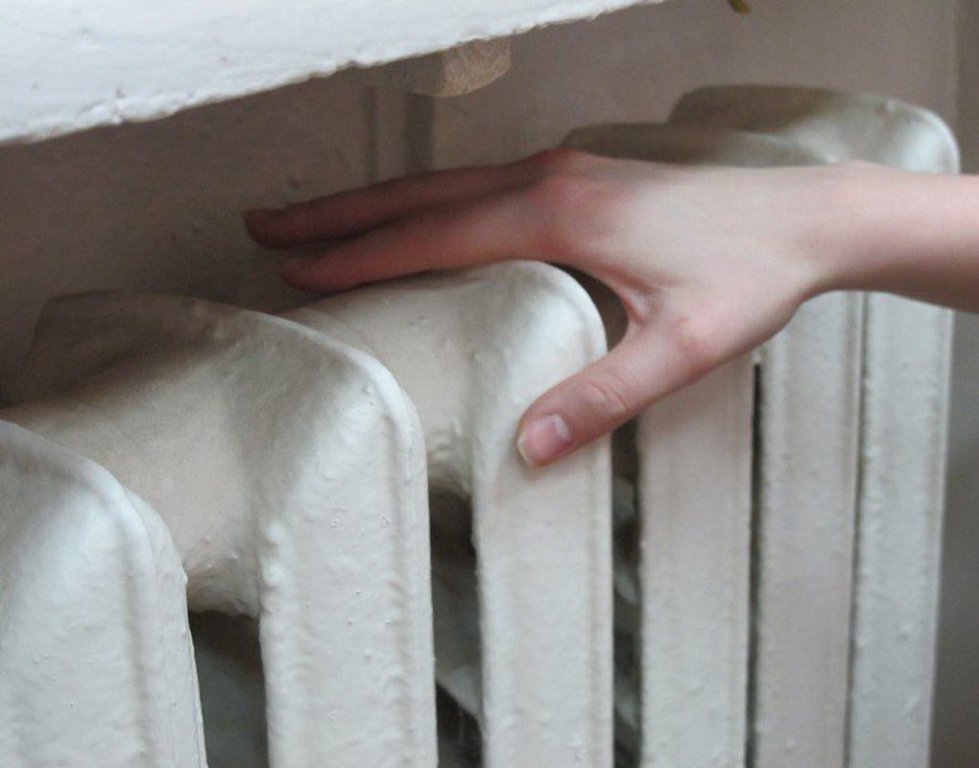
- In the most neglected cases - defrosting of the heating system or its individual sections. If the coolant circulation stops in the cold, the water in and the batteries will freeze very quickly. As the aggregate state changes to a solid state, it increases in volume, the pipelines and heating devices are broken.
Without washing
Washing of the heating system in a private house is not necessary if three conditions are met:
- Autonomous system (ie it is not connected to the heating main, but has its own heat source);
- It refers to closed heat supply systems (without selection of hot water from the heating circuit and, accordingly, without updating the coolant);
- It is equipped with a membrane expansion tank. Open tank means the evaporation of water and its periodic topping up.
![]()
If all conditions are fulfilled, the coolant in the absence of leaks circulates in a closed loop indefinitely. After precipitation of a small amount of salts and suspensions, which are contained in water, the contamination of pipes and radiators completely stops.
Established ways
Hydropneumatic
Hydropneumatic flushing of heating apartment building is held annually, immediately after the end of the heating season.
The essence of the method is the supply of pulp (a mixture of water and air) to the heating circuit running on the discharge. Air bubbles gradually break down the contaminants, and the flow of water carries them into the drain through an open drain valve.
I emphasize: washing should be carried out annually. For several years, the deposits in the batteries and pipes become so hard that the pulp can not break them.
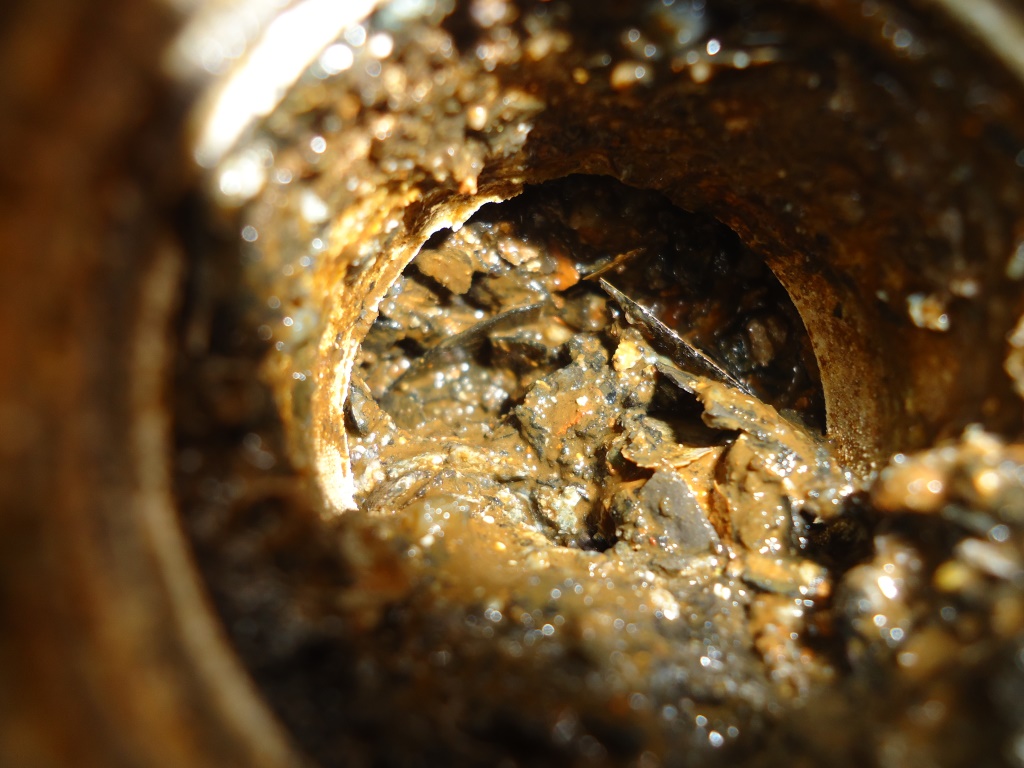
The person in charge of the work is the organization that serves your home. For flushing you need:
- Free access to the basement - in the elevator units of the house and to the stop valves on the risers;
- Air compressor, giving out pressure not less than 7кгс / см2;
![]()
- Reinforced hose with fittings on the ends. It will be needed to connect the compressor to the elevator.
To flush the heating system of an apartment house in the elevator unit, you need to assemble the following configuration:
- The outlet of the compressor is connected by a hose with a control valve on the feed after the water-jet elevator. The threads are sealed with plumbing or FUM tape;
- The house return gate valve is closed, and reset to return pipeline heating is open.
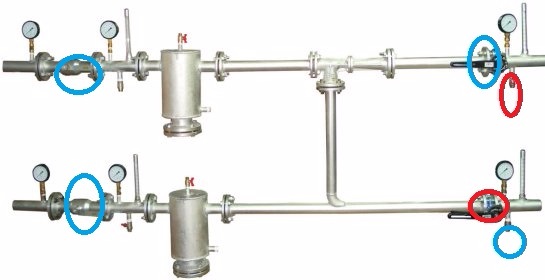
When the flushing is started, the compressor is first switched on. After the pressure on its pressure gauge exceeds the pressure at the connection point (4-5kgs / cm2), the control valve opens and together with the water the air circuit starts to flow into the reset circuit.
Hydropneumatic washing has one subtlety. Its effectiveness is provided by two factors:
- Amount of air in the pulp;
- Speed of movement pulp.
If a large number of heating risers are connected to the elevator unit, the pulp will be poor in air and will move slowly. The problem is solved by alternately flushing each small group of risers; The valve on the remaining risers for this time (about an hour) overlap.
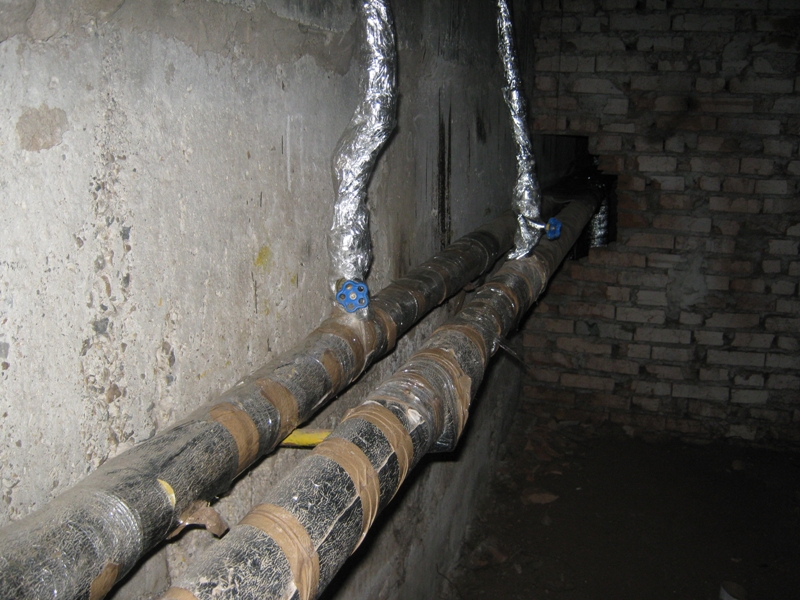
How do I know if the flushing is complete? According to the color of the water entering the discharge: when it becomes transparent, the compressor can be connected to the return line of heat supply.
To do this, it is necessary to assemble a new configuration in the elevator node:
- The compressor is connected to the control valve on the return line after the elevator;
- The house (shut-off heating circuit) valve on the return is open, and on the supply - closed;
- Reset on the feed is open.
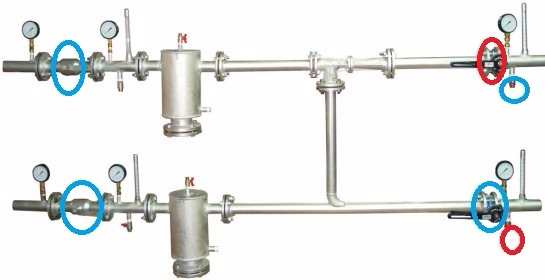
After the end of the flushing, the maximum amount of air must be expelled from the heating circuit. To do this, the elevator unit works on the discharge until a flat stream of water without air bubbles comes out of the discharger. After that, the reset and both house valves are closed.
At the end of the washing, the heating system must be inspected by a representative of the heat energy supplier - local heating systems. Usually the test consists in unscrewing one or two radiator plugs in the entrances or apartments. The norm is the absence of dense deposits inside the radiator.
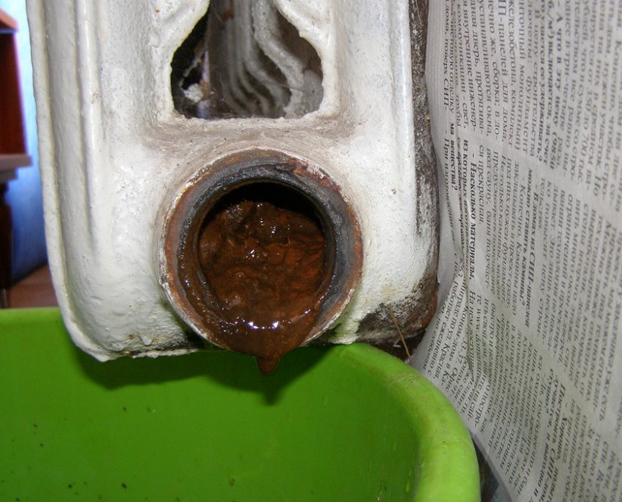
Chemical
Chemical flushing is used in small-scale heating heating systems (primarily private houses). In an apartment building this way, individual risers can be washed.
The essence of the method is in filling the circuit in place of the coolant with a solution of acid or alkali. Within a few hours they dissolve deposits and mud.
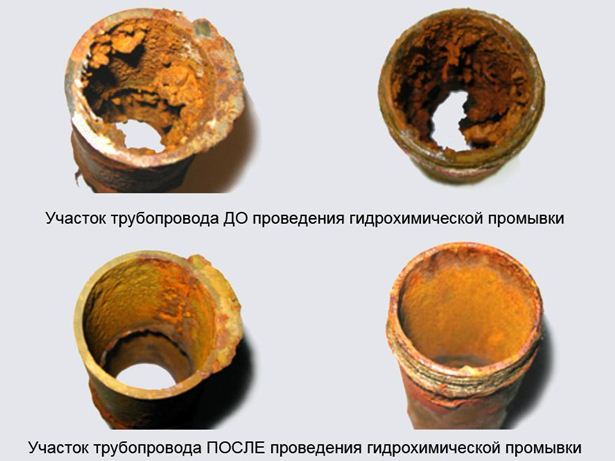
The method is extremely effective against calcium salts and rust, but it has two significant drawbacks:
- High price reagents;
- Necessity of their recycling after use. Alkaline or acid means for cleaning heating pipes can not simply be poured into the sewer.
For rinsing, the compressor station and the tank with the reagent solution are connected to any discharger or control valve. The heating system is filled and after a technological pause at 12 o'clock is reset, and then washed with water and put into operation.

Non-standard methods
Elevator without nozzle
How and what to wash the heating system of an apartment building in the absence of a compressor and a management campaign? Alas, this also happens at a distance from major cities.
In this case, often the work of the elevator assembly without nozzle helps for two or three days. With disconnected input, house and gate valves, the water-jet elevator is removed, the nozzle is removed from it, and the suction (bottom flange of the elevator) is muffled by a steel pancake.
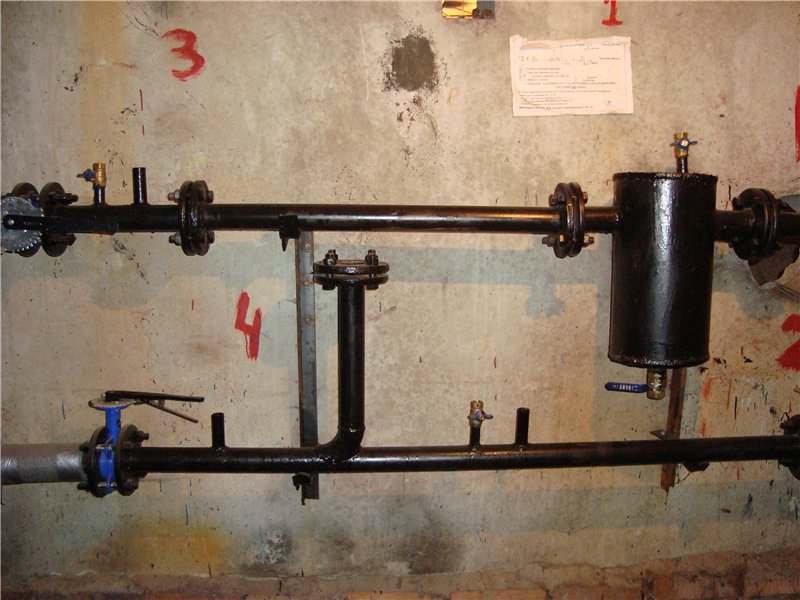
As a result:
- The temperature rises coolant in the heating circuit;
- The circulation is accelerated. The nozzle no longer limits the flow of water from the supply line of the heating main. The difference between the beginning and end of the contour is not normal 0.2 kg / cm2, but 2-3 atmospheres.

Why is this procedure abnormal? Because in this mode:
- Repeatedly increases heat consumption (that is, his supplier suffers losses);
- The temperature regime is violated work of the heating main. The return line is excessively hot water. Due to the technological cycle of the CHP operation, before the new cycle of circulation, it must be cooled to the required temperature.
Flushing valve
How do you wash the battery with your own hands, if the efficiency of the heater noticeably dropped over several years of operation?
To start in the summer, before the start of the heating season, it must be provided with a washing tap.

The best flushing is ball valve with threads "papa-mama" (external and internal), screwed into the radiator cap.
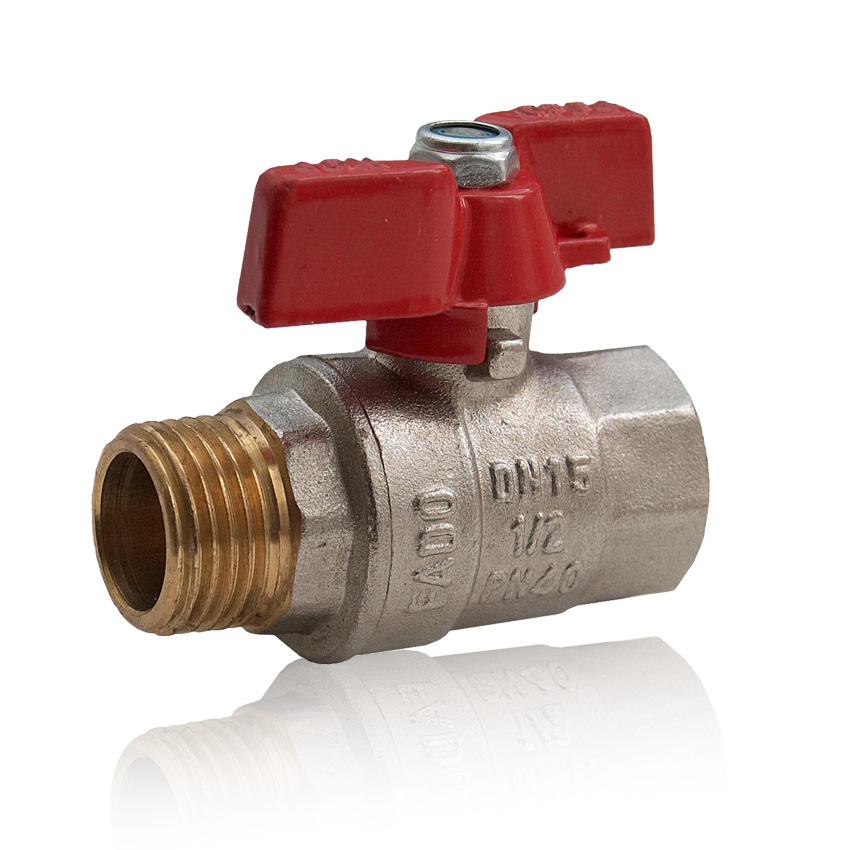
After the start of the heating, a common garden hose is connected to the flushing tap, which is clamped with a yoke on a short 1/2 "threaded spigot. The hose is sent to the sewer - in the toilet or in the release of the bath. It is necessary to open the tap - and accumulated in the extreme sections of the silt will fly out on the front of the water flow.
A few nuances:
- Faience is afraid of temperature changes. Therefore, it is better to insert the hose into the toilet bowl as deeply as possible, so that the hot water falls immediately into the riser;
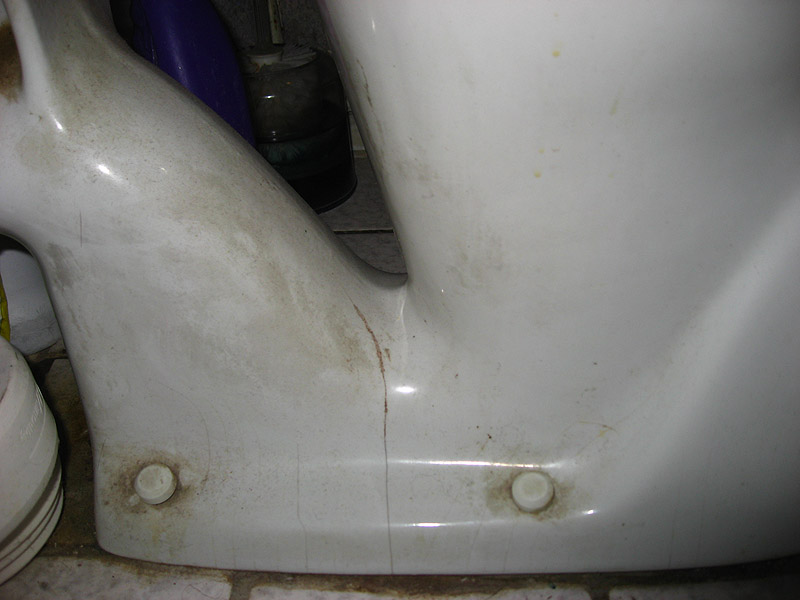
- Secure the hose. Otherwise, you risk conducting an off-schedule experiment, illustrating the jet movement. Taking into account the fact that hot and very dirty water will perform the role of the jet, the result will not please you;
- Wait until the water clears. While the discharge is dirty, continue washing.
Why did I classify this method of washing as non-standard? You see, the rules of operation closed systems Heat supply prohibits the withdrawal of water from the heating system. AT open systems a dump is possible in principle, but in our case it goes past the water meter and again leads to the flow of no-paid hot water.
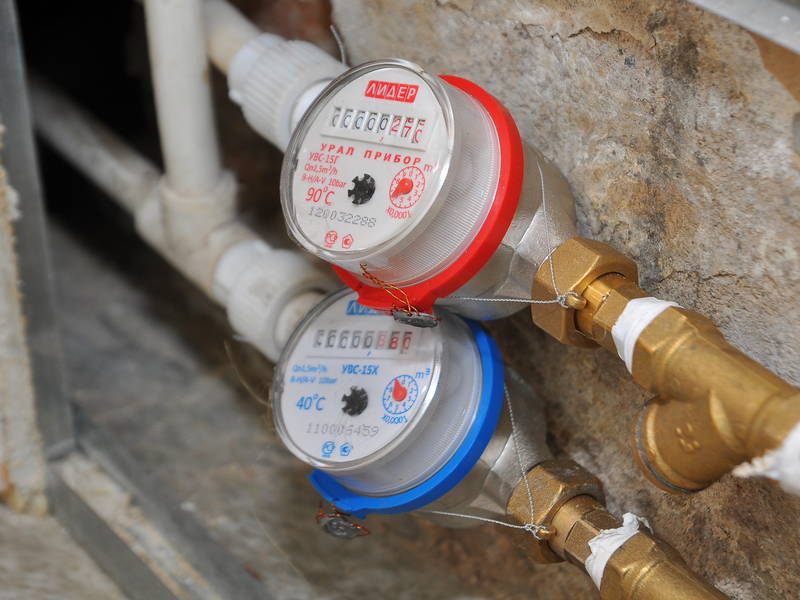
Washing is only necessary for radiators with side or diagonal connection. The more sections, the faster the last ones get muddied. With a two-way lower connection, continuous circulation through the lower corrector of the device does not allow it to sill.
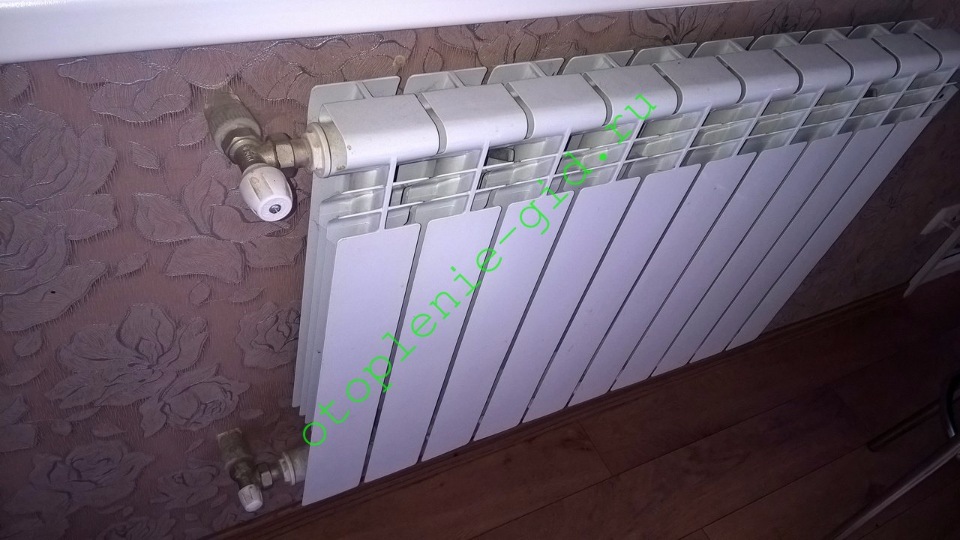
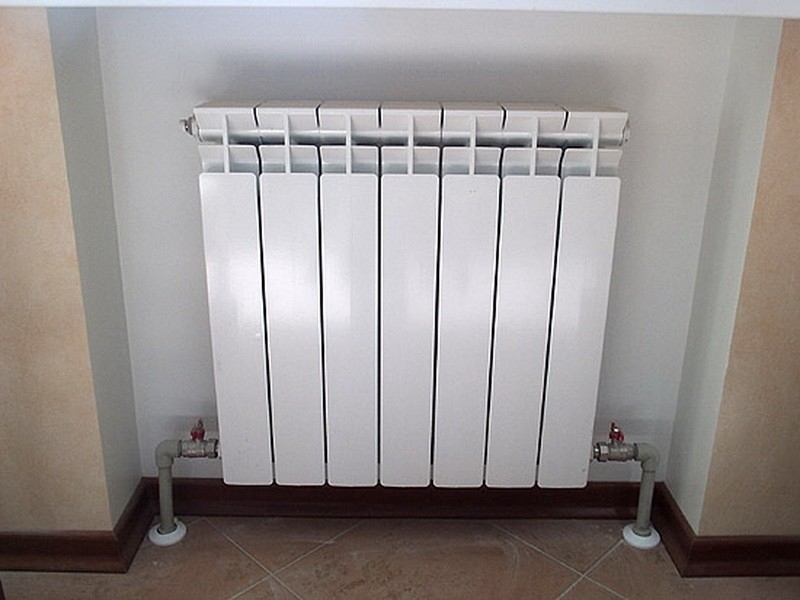
Radiator Restoration
What if the old cast-iron radiators remain cold even after washing?
A very primitive technology - annealing the batteries - will help you to get rid of the fossil sediments of the mud. They are dismantled and warmed up red in the fire spread out in the courtyard. Then the radiator is dismantled in sections, and each of them is taped with a wooden or rubber mallet.
After the straggler from the walls of the silt is poured from the collector, it remains only to reassemble the radiator with new inter-sectional gaskets.

After priming and painting condition cast-iron radiator nothing is different from the state of the new heating.
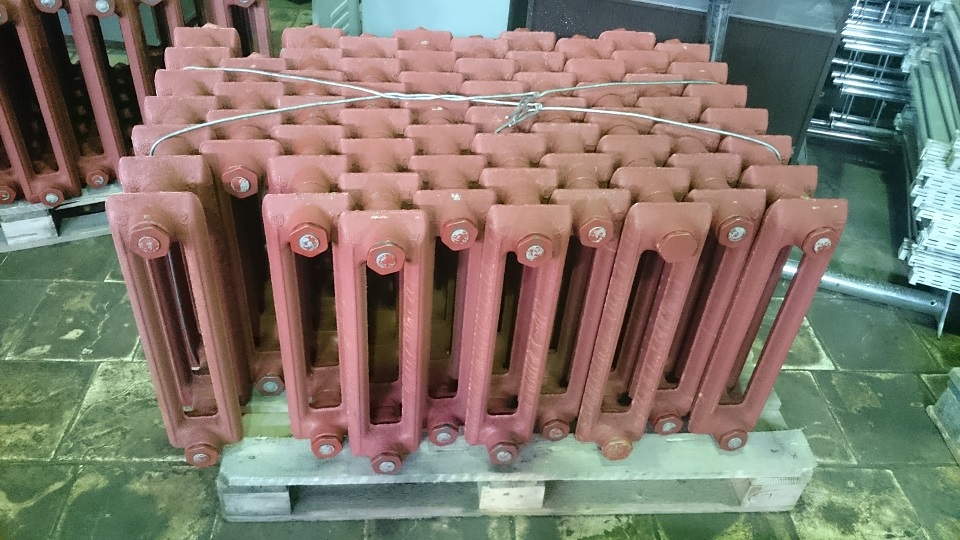
Conclusion
I hope that my experience will help the reader to enjoy the warmth in the house even in the coldest winters. You can learn more about washing by watching the video in this article. Waiting for your additions to it. Successes, comrades!
A high-quality and competently executed flushing of the heating system of a residential house ensures disposal of pipes and batteries from various deposits that can lead to serious blockages and failure of heating equipment.
1 Washing - why do you need this procedure?
The effective functioning of any modern heating system with water as a heat carrier depends on the temperature, magnitude and speed of the water flow flowing through the pipes. When salt deposits form and accumulate on their walls, the gaps in tubular products become smaller. Most often this is observed in the places of cuts and bends of pipelines, as well as in horizontal sections. Blockages lead to the fact that the heating equipment starts to work with incomplete payback and wears out quickly.
It is proved that the heat transfer decreases by 13-16% with the formation of deposits in the thickness of only 1 mm.
With the passage of time, the efficiency of the system becomes even smaller, but the cost of heating the water increases. To tolerate this there is no sense, since the problem is solved, in general, quite simply - by flushing pipes and radiators. Sanitary rules recommend conducting it in cases where you note the following "painful symptoms" of the functioning of the heating system:
- some parts of the battery heat up strongly, while others remain cold;
- the pipe, led to the battery, has a high temperature, and the radiator stays cold;
- the heating system starts warming up very long, which was not fixed before.
Most often clogged pipes of steel, which do not have a special anti-corrosion coating. In them, clogs are formed due to rusting of products and mineralization of water on the inner surface. Are prone to the formation of deposits and (pipes), in which hot water often stagnates, which leads to their silting. For this reason, heating elements of iron and steel need to be cleaned regularly, without waiting until the clearance in them drops to zero, which will require a complete replacement of the pipeline and radiators.
Equipment made of "stainless steel" and galvanized steel alloys, aluminum and need to be washed much less often. But they also need to be cleaned more or less regularly, given the low quality of cleaning units and complexes installed in enterprises that supply heat to our apartments.
A complete flushing of the heating system of apartment buildings and private houses makes it possible to get rid of the deposits and layers that have accumulated in it during the operation. The cost of such an event depends on:
- length and dimensions of pipes and batteries;
- the degree of contamination of the system and the type of pollution;
- type of washing and equipment used for it.
You can find out the specific price for the service from the work you have chosen. The cost of the latter is always determined individually. Usually the flushing of the heating system of a multi-apartment building costs at least 2.5-3 thousand rubles.
2 Flushing options - how to return the operation of the heating system?
Technologies and rules for cleaning heat and sanitation utilities of residential buildings are described in Sanitary standards 3.05.03-85 and 3.05.01-85. These standards require the flushing of heat systems after the heating season and before it starts. Such cleaning, performed every six months, is called preventive.
There is also an active flushing. It is held as needed at any time. In this case, the rules require that the water supply to the house is blocked, and heating - completely off.
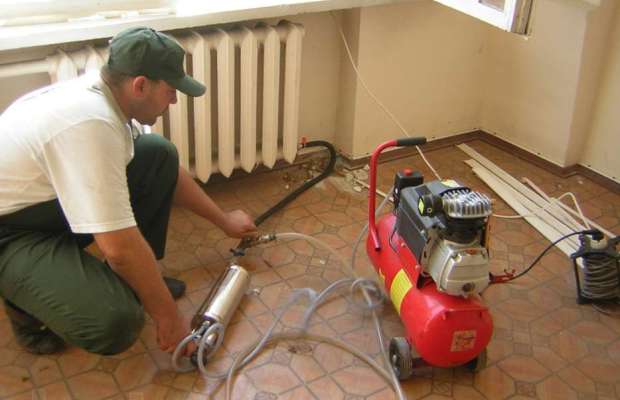
Now flushing is carried out using several technologies. She may be:
- hydrodynamic;
- chemical;
- hydropneumatic;
- pneumohydroimpulse.
Any of these techniques is designed to return the system high functionality. The choice of a specific technology for cleaning pipes and batteries is done after careful diagnosis, which aims to clarify the nature, exact composition and special properties formed scale. On the basis of these data, the equipment that will be optimal for flushing the system is selected, and a technological map and rules for carrying out the cleaning activities are developed.
It should be noted that generally accepted washing techniques have their own "pluses" and "minuses". The frequency of application of each of them is different. Some technologies are not suitable for cleaning systems from any specific materials. For this reason, the selection and conduct of flushing operations should only be carried out by specialists in such matters. They, as a rule, advise consumers to use chemical and hydropneumatic technologies.
3 Chemical cleaning of pipes - effective, but not always expedient
Economically justified technology, demonstrating good results, is chemical flushing. With the right selection of drugs, it perfectly removes blockages in batteries and pipes. It is based on the supply of specially selected compounds (all kinds of alkalis, mineral and organic acids, etc.) into the system, which dissolve the deposits. In the end they are washed out of the pipes with water.
For each reagent used for washing, there is own instruction for use. It describes which systems can be processed with the drug. Just note that chemical compounds are not recommended for washing pipes and radiators from aluminum alloys. They are also not suitable for systems that are highly depreciated. Aggressive substances of chemical compounds can destroy the thin walls of pipe communications.
Before applying the chemical flushing, the specialists are compulsorily studied:
- pipeline diagram for project documentation on house;
- design of radiators;
- pipe material;
- pollution level of the system.
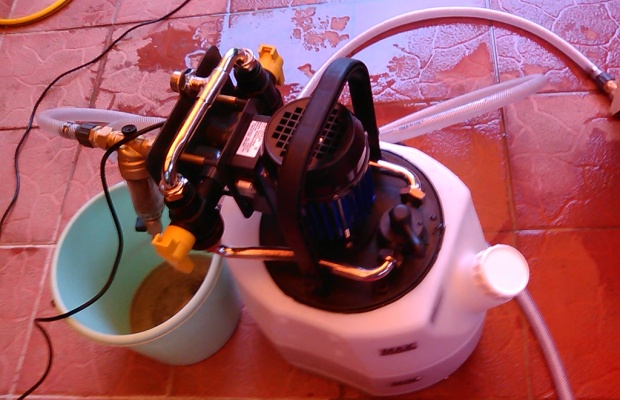
Only after the analysis of these data can "designate" a particular preparation for cleaning the heating system, it can be supplied to the pipeline in liquid or powder form, for the supply of reagents, special equipment is used - pump, tanks, hoses that are not afraid of chemical attack.
The advantage of this washing technique is that the procedure can be performed even in winter. The heating system does not need to be switched off for the time it is processed with chemicals. As a rule, high quality of cleaning is achieved for 24-48 hours of chemical composition in pipes and batteries. Sometimes it takes a little more time.
How much will the washing actually last, experts know, who examined your system. But in any case, it will not cause inconvenience to tenants at home. And most importantly - the frequency of the recurrence of such clean-up measures is 7-9 years. That is, after processing the system with reagents, you can not worry for a long time about the efficiency of heating in your home.
4 Hydropneumatic flushing is common and popular
The composition of deposits in heating networks usually includes salts of various elements - magnesium, sodium, cadmium. They are very "tenacious" kept on the pipes, while their structure is quite fragile. It is not difficult to destroy it if a hydropneumatic compressor is used. It injects air, which forms active turbulent vortices in the pipes. And they without any problems break the deposits of salts.
The scheme of washing the system using such equipment is described below:
- On the return pipeline the valve closes.
- The compressor is connected to the system inspection valve.
- The discharge of water on the return is opened.
- We wait until the pressure in the compressor equipment (in its ballast tank) reaches 6 kgf / cm2, and then open its valve.
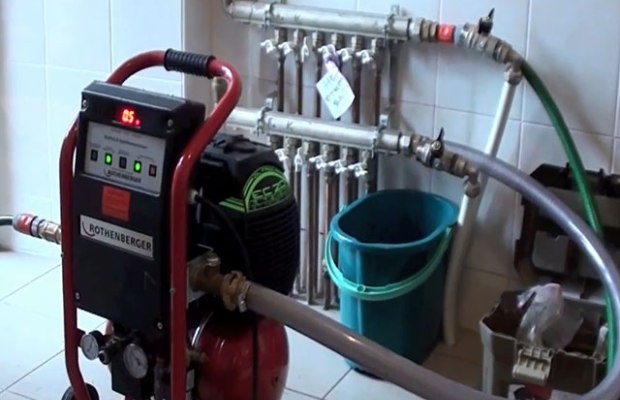
Then you need to alternately overlap the risers (or entire groups) and perform cleaning. The duration of the procedure can be different. The need for the end of the washing is indicated by the clear water that goes to the discharge. Once it becomes clean, the second part of the hydropneumatic technique can be performed. The scheme of work is as follows:
- Close the valve to which the compressor is connected, as well as reset.
- We overlap the latch on the feed, and open it on the return.
- We start the reset from the feeder and connect the compressor on the return line to the inspection valve.
- We turn on the equipment and perform the washing according to the above principles.
Pneumohydroimpulse and hydrodynamic flushing are still rarely used, as they are inferior in effectiveness to the techniques discussed above.

